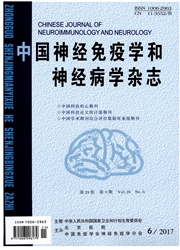

 中文摘要:
中文摘要:
目的研究视神经脊髓炎(neuromyelitis optica,NMO)患者血清中超敏C-反应蛋白(high sensitivity C-reactive protein,hs-CRP)水平及其与疾病临床特点的相关性。方法测定并比较50例NMO急性期患者、30例重症肌无力(myasthenia gravis,MG)患者(作为疾病对照)、58名健康对照者的血清hs-CRP水平,并分析50例NMO急性期血清hs-CRP水平与其临床特点的相关性;同时比较NMO患者的急性期与缓解期的血清hsCRP水平。结果 NMO急性期组血清hs-CRP水平为(2.2±2.7)mg/L,MG组为(0.8±0.9)mg/L,健康对照组为(0.8±0.9)mg/L,三组间比较差异有统计学意义(F=8.834,P〈0.001),NMO急性期组高于MG组(t=3.204,P=0.002)及健康对照组(t=3.508,P=0.001)。31例NMO急性期患者经治疗后病情稳定缓解,急性期血清hs-CRP水平〔(2.7±3.2)mg/L〕高于NMO缓解期〔(1.2±1.3)mg/L〕(t=2.797,P=0.009)。50例NMO急性期患者血清hs-CRP水平与复发的间隔时间呈负相关(r=-0.445,P=0.038),与患者首发年龄、扩展残疾状态量表(EDSS)评分、脊髓MRI受累节段数、水通道蛋白4抗体(AQP4-Ab)水平无相关性(均P〉0.05)。结论 NMO患者血清hs-CRP水平与其疾病活动性密切相关。血清hs-CRP水平可能对下一次复发时间有一定预示作用,但不能反映疾病的严重程度。
 英文摘要:
英文摘要:
Objective To investigate the relationship of the serum high sensitivity C-reactive protein(hs-CRP)level with the clinical features of acute neuromyelitis optica(NMO)patients.Methods The serum hsCRP levels were measured and analyzed in 50 acute NMO patients,30 myasthenia gravis(MG)patients and 58age-and sex-matched healthy controls(HC).The correlation between serum hs-CRP levels and clinical features of NMO were analyzed.The serum hs-CRP levels of the acute and remit period of NMO patients were compared.Results The serum hs-CRP levels in acute NMO group,the MG and HC groups were(2.2±2.7)mg/L,(0.8±0.9)mg/L and(0.8±0.9)mg/L.There were significant differences of serum hs-CRP levels among the three group(F=8.834,P〈0.001).The serum hs-CRP levels in acute NMO patients were significantly higher than those in MG patients(t=3.204,P=0.002)and HC(t=3.508,P=0.001),while there were no differences between MG group and HC groups(P〉0.05).The serum hs-CRP levels of 31 remit NMO patients with remission after treatment[(1.2±1.3)mg/L]was lower than that of the acute ones[(2.7±3.2)mg/L,t=2.797,P=0.009].In acute NMO group,serum hs-CRP levels were negatively correlated with the time to next attack(r=-0.445,P=0.038),but the levels were not correlated with age at onset,number of segments of spinal cord involved,EDSS score,titer of AQP4-Ab(P〉0.05,respectively).Conclusions The sera hs-CRP in NMO patients are closely related with the disease activity and may indicate the recurrence time.But it can not reflect the severity of the disease.
 同期刊论文项目
同期刊论文项目
 同项目期刊论文
同项目期刊论文
 Interleukin-10 producing-B cells and their association with responsiveness to rituximab in myastheni
Interleukin-10 producing-B cells and their association with responsiveness to rituximab in myastheni Anti-Inflammatory Effects of Vinpocetine in Atherosclerosisand Ischemic Stroke: A Review of the Lite
Anti-Inflammatory Effects of Vinpocetine in Atherosclerosisand Ischemic Stroke: A Review of the Lite Clinical Features and Sera Anti-Aquaporin 4 Antibody Positivity in Patients with Demyelinating Disor
Clinical Features and Sera Anti-Aquaporin 4 Antibody Positivity in Patients with Demyelinating Disor INTERLEUKIN-10 PRODUCING- B CELLS AND THEIR ASSOCIATION WITH RESPONSIVENESS TO RITUXIMAB IN MYASTHEN
INTERLEUKIN-10 PRODUCING- B CELLS AND THEIR ASSOCIATION WITH RESPONSIVENESS TO RITUXIMAB IN MYASTHEN 期刊信息
期刊信息
